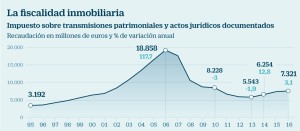
The real estate market is encouraged after hitting bottom in 2013 and these have positive reflection in the public coffers. The sale of new homes is taxed through the VAT and the property transfer tax when they are second-hand houses. Los últimos datos publicados por la Agencia Tributaria reflejan que el gasto sujeto a IVA en la compra de casas por parte de los hogares alcanzó los 16.334 million, a 7,3% more than the previous year. This contributed to the main indirect tax reached a historical collection. It closed the previous year bringing to public housing 62.845 million, a 7,8% more than in the same period of the previous year. Although the situation has improved, Spaniards invest today 70.000 million less in housing than in 2006.
Recovery by capital transfer tax and stamp tax – levied procedures as the formalization of a mortgage - reached the 7.321 million, a 3,1% more than the previous year. Ambos tributos son ingresados por las autonomous communities. The closing figures of 2016 they reflect that, Despite the improvement, There was a slowdown. The increase in revenues from property transfer and legal acts reached the 12,8% in 2014 and the 13,6% in 2016, figures far higher than those registered the previous year. The improvement was preceded by a collapse of unprecedented fundraising.
Para entender la magnitud de la real estate bubble y su derrumbe no hay mejor indicador que el impuesto de transmisiones y actos jurídicos. In 2006, at the zenith of the expansion, communities raised 18.958 million by both tax figures. Today, Despite the improvement in the last three years, the fundraising follows a 61% below the pre-crisis economic figures. Today, communities raise 11.6000 million less for the brick that ten years.
The situation has been very uneven depending on the autonomous community. Francina Armengol Balearic Government managed last year 544 millones por el impuesto sobre transmisiones patrimoniales y documented legal acts, a 18,5% more. It was the community that registered a higher increase of the levy. It is followed by Catalonia, you entered a 12,1% more to the 1.652 million. The Government also is the administration which achieved more revenue in absolute numbers. In third place was Aragon, with an increase of the 6,5%, far from Catalonia and the Balearic Islands.
En el lado opuesto destacó Galicia and La Rioja, that looked at such as the levying of tax fell a 14% and a 13,7%, respectively. The decrease was due to the lower activity in the real estate sector since none of the two communities adopted changes in sufficient depth to explain the reverse.
Communities have a wide jurisdiction to set types and sections in the property transfer tax. Assessments are moved between the 10% vigente en Catalonia, Galicia or the Valencian Community to the 6,5% Canary Islands, the 6% of Madrid o el 7% La Rioja. There are also communities that have opted to fix sections. For example, Andalusia applies an assessment of the 8% lower housing to 400.000 euros, a guy who comes up to the 7% When the price amounts to the 700.000 euros. From this threshold, applies a type of the 10%. Castilla y León, Cantabria and Extremadura are other communities that have opted to fix sections.
Councils have less exposure to the vagaries of the real estate sector. Su principal fuente de ingresos propios es el IBI, that gravel properties holding and not transfer. This makes it a counter-cyclical tax and, In fact, es el único impuesto del sistema tributario español whose collection has never fallen. The latest data reflect councils admitted almost 13.000 million by IBI, that is the most important tax room by fundraising.
Read more: http://cincodias.elpais.com/cincodias/2017/04/12/midinero/1492016893_109906.html